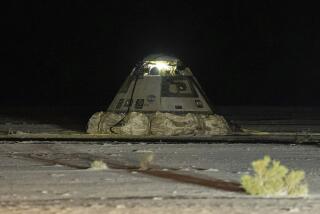In the end, it’s nothing but blue skies for Atlantis
- Share via
The space shuttle Atlantis and its crew of seven returned to Earth on Sunday at Edwards Air Force Base in the Mojave Desert, announcing its approach with twin sonic booms.
Atlantis circled Earth 197 times and traveled 5.3 million miles before ending its daring 13-day mission to refurbish the Hubble Space Telescope.
The shuttle, which landed at 8:39 a.m., had been diverted to California after nasty weather prevented a landing at Kennedy Space Center in Florida.
The shuttle had been scheduled to land Friday, then Saturday, but the Florida storms made it too dangerous. Mission Control had hoped to avoid the time and expense -- about $1.8 million -- of diverting to Edwards. NASA said it would take about a week to prepare Atlantis for its ferry flight back to Kennedy atop a Boeing 747.
Out on the runway after landing Sunday, shuttle commander Scott Altman reflected on how long it had taken to get the mission underway -- and then to end it.
“When we got down to Florida, I looked at everybody and said, ‘At last,’ ” Altman said. “I didn’t realize it was going to be so hard to get back to Earth in the end. So, again, I guess I say the same thing: At last we’re back on the ground.”
Alan Brown, a NASA spokesman at the Dryden Flight Research Center at Edwards, said Atlantis accomplished major repairs of the telescope and extended its life through at least 2014.
The crew replaced one wide-field camera, swapped out several batteries and placed stainless steel “blankets” over the telescope, among other upgrades and repairs.
One repair was particularly difficult: fixing the telescope’s imaging spectrograph, which scans for black holes. That took more than eight hours but was successful.
The astronauts retrieved Hubble’s old wide-field camera so it could be displayed at the Smithsonian Institution. The replacement camera and other new instruments will enable Hubble to peer deeper into the universe.
The $1-billion repair mission almost didn’t happen. It was canceled in 2004, a year after the shuttle Columbia tragedy, because of the dangers of flying into a 350-mile-high orbit that did not offer shelter in case Atlantis suffered damage from launch debris or space junk. Launch debris damaged Columbia’s wing, leading to its destruction during reentry and the death of its seven crew members.
NASA reinstated the Hubble repair flight after intense public protest and after developing a rescue plan and shuttle repair kits. Shuttle Endeavour was on standby for a possible rescue mission until late last week, after inspections found Atlantis’ thermal shielding to be solid for reentry.
Endeavour will be prepped for a June flight to the International Space Station.
Sunday’s landing was the 53rd at Edwards.
--
The Associated Press contributed to this report.
More to Read
Sign up for Essential California
The most important California stories and recommendations in your inbox every morning.
You may occasionally receive promotional content from the Los Angeles Times.













